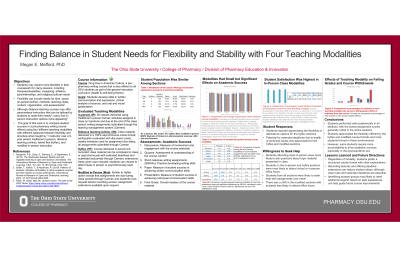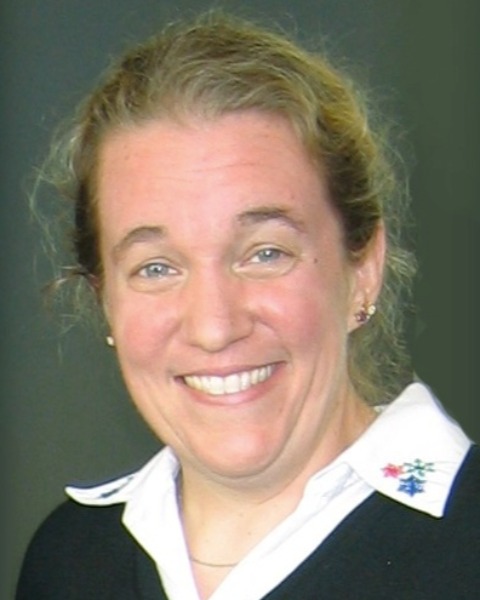Biological Sciences
(185) Finding Balance in Student Needs for Flexibility and Stability with Four Teaching Modalities


Megan E. Mefford, PhD
Senior Lecturer
The Ohio State University College of Pharmacy
Columbus, Ohio, United States
Primary Author(s)
Objective : To compare student academic performance and satisfaction in a pre-pharmacy writing class taught with four teaching modalities (in-person, online, hybrid flex, and modified in-person).
Methods: A pre-pharmacy writing course was administered by the same instructor using 4 teaching modalities over a 5-year period: traditional in-person (n=78 students); online asynchronous (n=116); hybrid-flex (hyflex) with in-person or asynchronous virtual options dependent on student choice (n=113); and modified in-person (modified) with access to lecture recordings and virtual assignment options as needed (n=186). Student success was measured using course grades. Satisfaction was assessed through student evaluations, course surveys, and willingness to seek instructor help
Results: Class participation grades were high independent of the teaching modality and did not significantly vary among groups (p=0.1, ANOVA). However, final project grades (p=0.03, ANOVA), presentation scores, and final course grades (p < 0.01, ANOVA for both comparisons) were highest for the in-person and modified sections. Student satisfaction scores were high for all course modalities but peaked for the hyflex and modified classes. Students in these sections reported that the flexibility in course delivery increased their feelings of accommodation and decreased their stress. Students in all modalities showed a willingness to seek instructor help, although the communication channels differed among teaching modalities.
Conclusions: Students appreciated being given autonomy over their learning and overall successfully navigated the increased flexibility provided by the hyflex teaching modality. However, the modified in-person framework, which combined needed flexibility with a more stable in-person course delivery structure, contributed most to student success. Learning to navigate this balance and advocate for their educational needs within a structured environment may contribute to student success in pharmacy school and beyond.
Methods: A pre-pharmacy writing course was administered by the same instructor using 4 teaching modalities over a 5-year period: traditional in-person (n=78 students); online asynchronous (n=116); hybrid-flex (hyflex) with in-person or asynchronous virtual options dependent on student choice (n=113); and modified in-person (modified) with access to lecture recordings and virtual assignment options as needed (n=186). Student success was measured using course grades. Satisfaction was assessed through student evaluations, course surveys, and willingness to seek instructor help
Results: Class participation grades were high independent of the teaching modality and did not significantly vary among groups (p=0.1, ANOVA). However, final project grades (p=0.03, ANOVA), presentation scores, and final course grades (p < 0.01, ANOVA for both comparisons) were highest for the in-person and modified sections. Student satisfaction scores were high for all course modalities but peaked for the hyflex and modified classes. Students in these sections reported that the flexibility in course delivery increased their feelings of accommodation and decreased their stress. Students in all modalities showed a willingness to seek instructor help, although the communication channels differed among teaching modalities.
Conclusions: Students appreciated being given autonomy over their learning and overall successfully navigated the increased flexibility provided by the hyflex teaching modality. However, the modified in-person framework, which combined needed flexibility with a more stable in-person course delivery structure, contributed most to student success. Learning to navigate this balance and advocate for their educational needs within a structured environment may contribute to student success in pharmacy school and beyond.

.png)